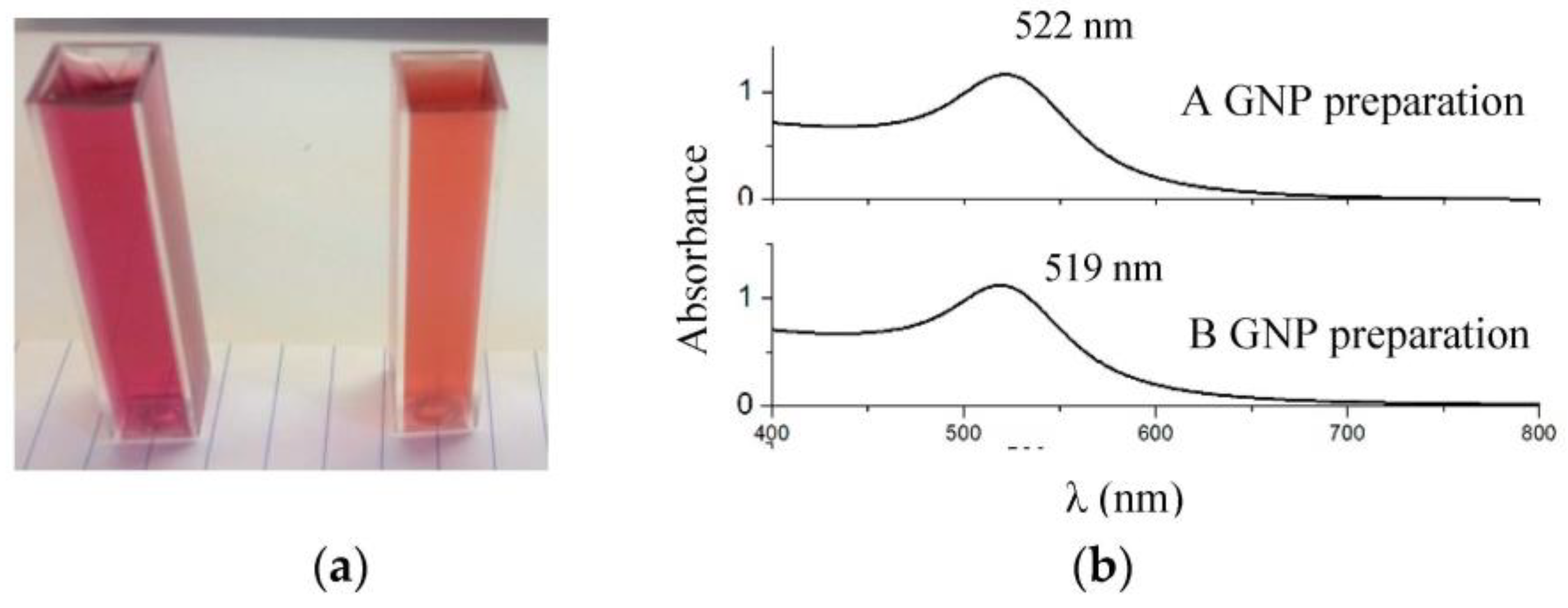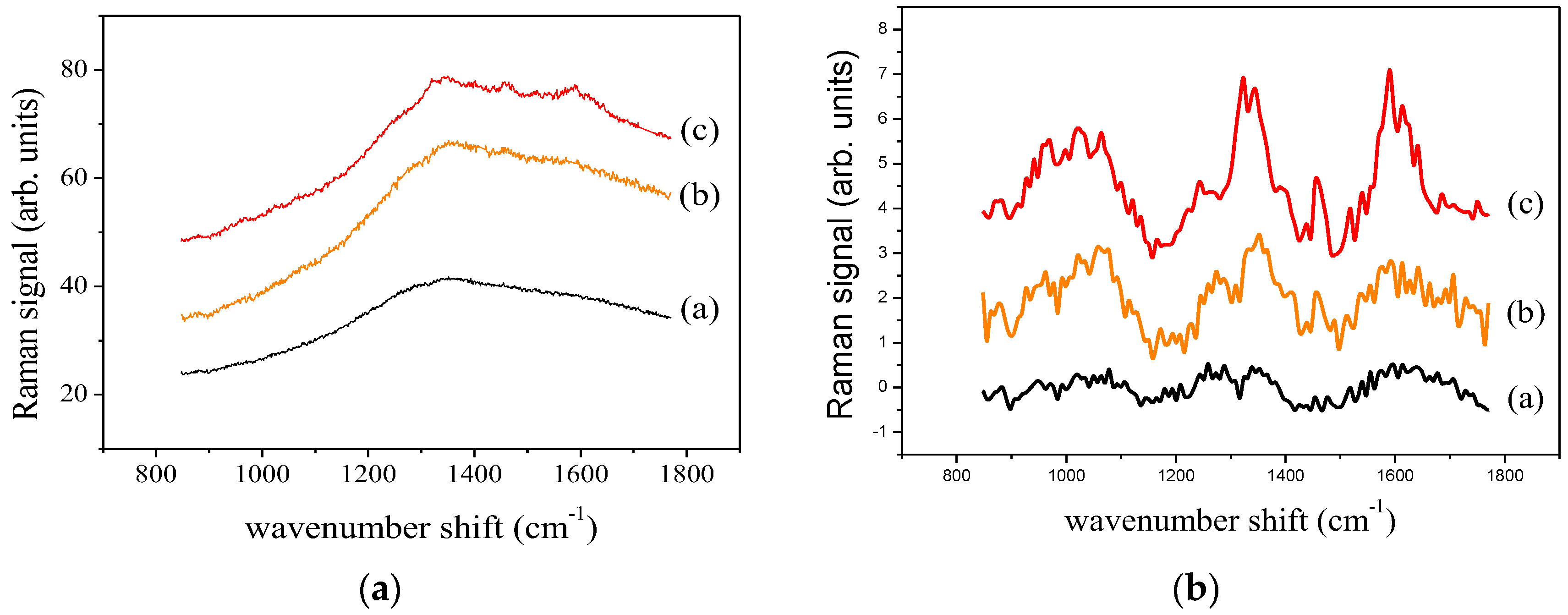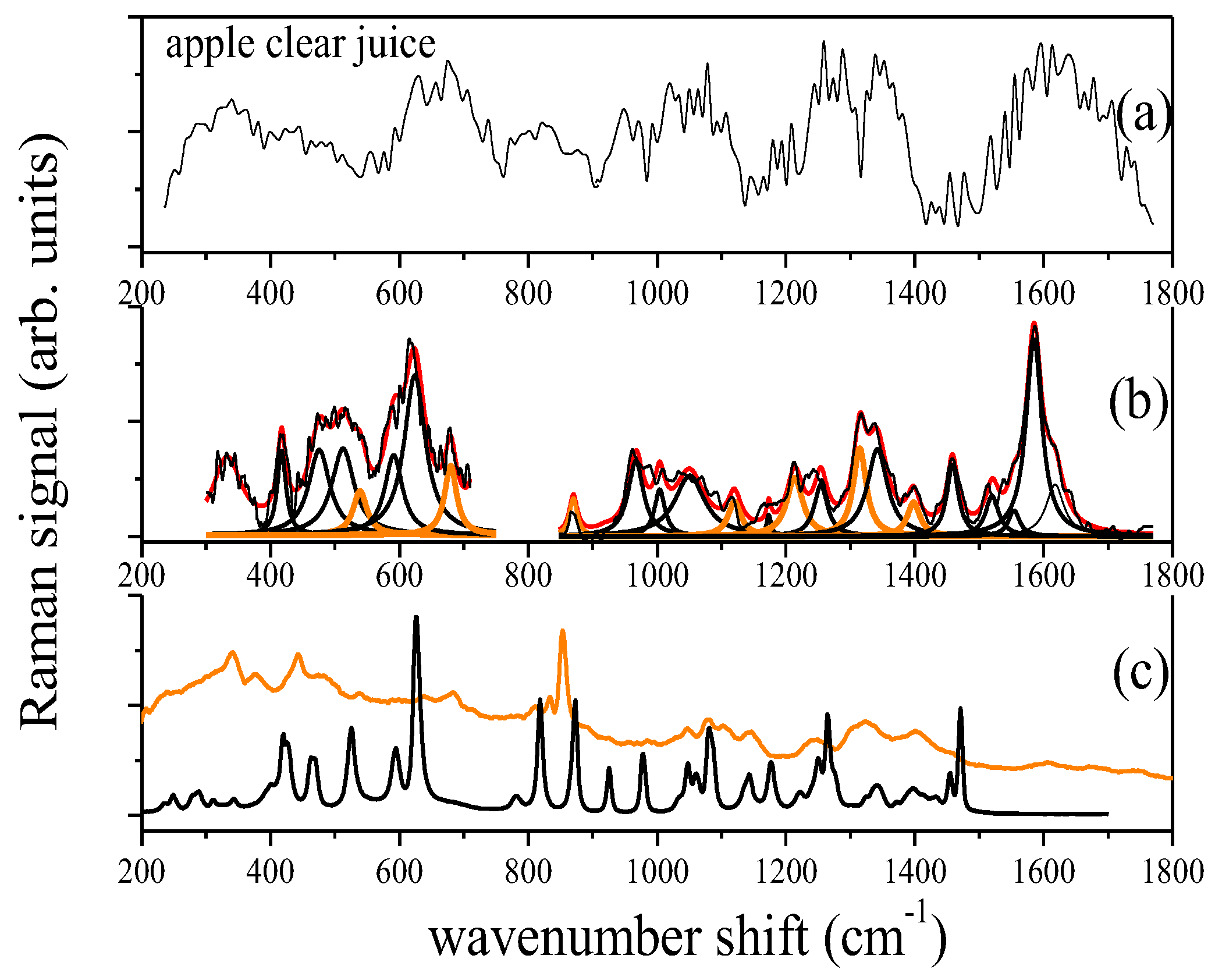Surface-Enhanced Raman Spectroscopy Study of Commercial Fruit Juices †
Abstract
:1. Introduction
2. Experiments
2.1. Materials
2.2. Nanoparticle Preparation and Characterization
2.3. Sample Preparation
2.4. Micro-Raman Spectroscopy Measurements
2.5. Data Analysis
3. Results
3.1. Nanoparticle Characterization and Substrate Selection
3.2. Raman and SERS Measurements
4. Conclusions
Author Contributions
Conflicts of Interest
References
- Bonifacio, A.; Cervo, S.; Sergo, V. Label-free surface-enhanced Raman spectroscopy of biofluids: Fundamental aspects and diagnostic applications. Anal. Bioanal. Chem. 2015, 407, 8265–8277. [Google Scholar] [CrossRef] [PubMed]
- Delfino, I.; Bizzarri, A.R.; Cannistraro, S. Single Molecule detection of Yeast Cytochrome c by Surface-Enhanced Raman Spectroscopy. Biophys. Chem. 2005, 113, 41–51. [Google Scholar] [CrossRef] [PubMed]
- Camerlingo, C.; Zenone, F.; Delfino, I.; Diano, N.; Mita, D.G.; Lepore, M. Investigation on clarified fruit juice composition by using visible light micro-Raman spectroscopy. Sensors 2007, 7, 2049–2061. [Google Scholar] [CrossRef] [PubMed]
- Delfino, I.; Camerlingo, C.; Portaccio, M.; Della Ventura, B.; Mita, L.; Mita, D.G.; Lepore, M. Visible micro-Raman spectroscopy for determining glucose content in beverage industry. Food Chem. 2011, 127, 735–742. [Google Scholar] [CrossRef] [PubMed]
- Craig, A.P.; Franca, A.S.; Irudayaraj, J. Surface-Enhanced Raman Spectroscopy Applied to Food Safety. Annu. Rev. Food Sci. Technol. 2013, 4, 369–380. [Google Scholar] [CrossRef] [PubMed]
- Liu, B.; Zhou, P.; Liu, X.; Sun, X.; Li, H.; Lin, M. Detection of pesticides in fruits by Surface-Enhanced Raman Spectroscopy coupled with gold nanostructures. Food Bioprocess Technol. 2013, 6, 710–718. [Google Scholar] [CrossRef]
- Frens, G. Particle size and sol stability in metal colloids. Colloid Polym. Sci. 1972, 250, 736–741. [Google Scholar] [CrossRef]
- Camerlingo, C.; Zenone, F.; Gaeta, G.M.; Riccio, R.; Lepore, M. Wavelet data processing of micro-Raman spectra of biological samples. Meas. Sci. Technol. 2006, 17, 298–303. [Google Scholar] [CrossRef]
- Haiss, W.; Thanh, N.T.K.; Aveyard, J.; Ferni, D.G. Determination of Size and Concentration of Gold Nanoparticles from UV-Vis Spectra. Anal. Chem. 2007, 79, 4215–4221. [Google Scholar] [CrossRef]
- De Gelder, J.; de Gussem, K.; Vandenabeele, P.; Moens, L. Reference database of Raman spectra of biological molecules. J. Raman Spectrosc. 2007, 38, 1133–1147. [Google Scholar] [CrossRef]
- Raman Spectra of Carbohydrates. Available online: www.models.life.ku.dk/specarb (accessed on 10 October 2016).
- Engelsen, S.B.; Noorgard, L. Comparative vibrational spectroscopy for determination of quality parameters in amidated pectins as evaluated by chemometrics. Carbohydr. Polym. 1996, 30, 9–24. [Google Scholar] [CrossRef]





Publisher’s Note: MDPI stays neutral with regard to jurisdictional claims in published maps and institutional affiliations. |
© 2016 by the authors. Licensee MDPI, Basel, Switzerland. This article is an open access article distributed under the terms and conditions of the Creative Commons Attribution (CC BY) license (http://creativecommons.org/licenses/by/4.0/).
Share and Cite
Camerlingo, C.; Portaccio, M.; RosaritaTatè; Lepore, M.; Delfino, I. Surface-Enhanced Raman Spectroscopy Study of Commercial Fruit Juices. Proceedings 2017, 1, 25. https://doi.org/10.3390/ecsa-3-C003
Camerlingo C, Portaccio M, RosaritaTatè, Lepore M, Delfino I. Surface-Enhanced Raman Spectroscopy Study of Commercial Fruit Juices. Proceedings. 2017; 1(2):25. https://doi.org/10.3390/ecsa-3-C003
Chicago/Turabian StyleCamerlingo, Carlo, Marianna Portaccio, RosaritaTatè, Maria Lepore, and Ines Delfino. 2017. "Surface-Enhanced Raman Spectroscopy Study of Commercial Fruit Juices" Proceedings 1, no. 2: 25. https://doi.org/10.3390/ecsa-3-C003
APA StyleCamerlingo, C., Portaccio, M., RosaritaTatè, Lepore, M., & Delfino, I. (2017). Surface-Enhanced Raman Spectroscopy Study of Commercial Fruit Juices. Proceedings, 1(2), 25. https://doi.org/10.3390/ecsa-3-C003




